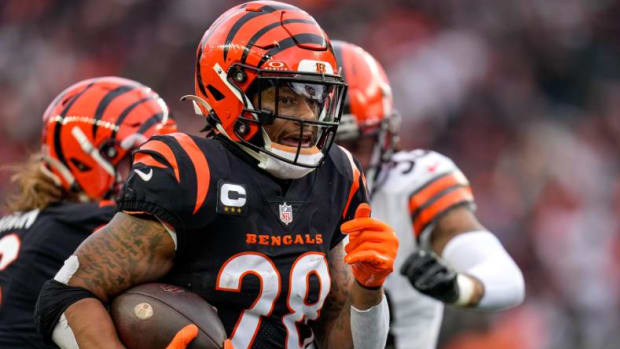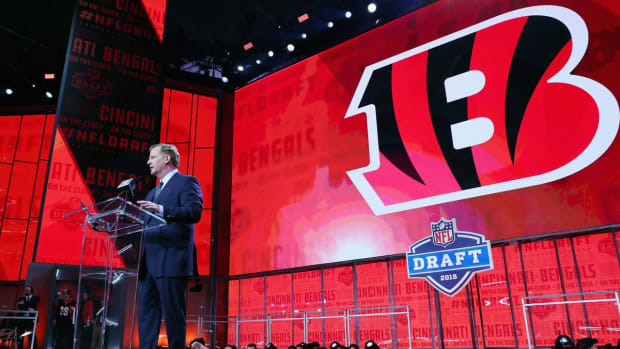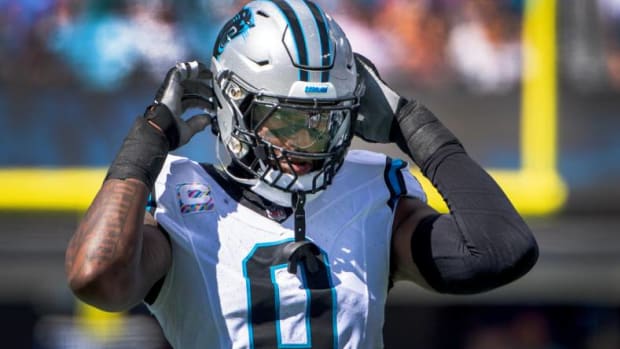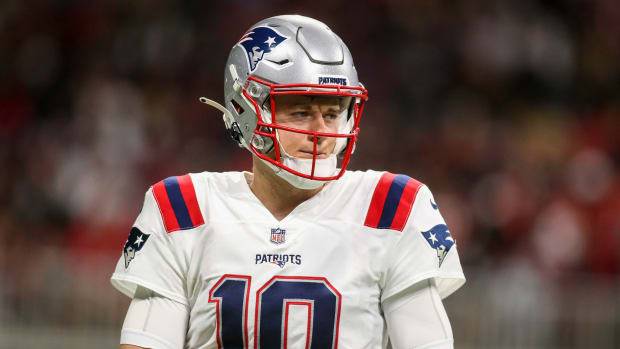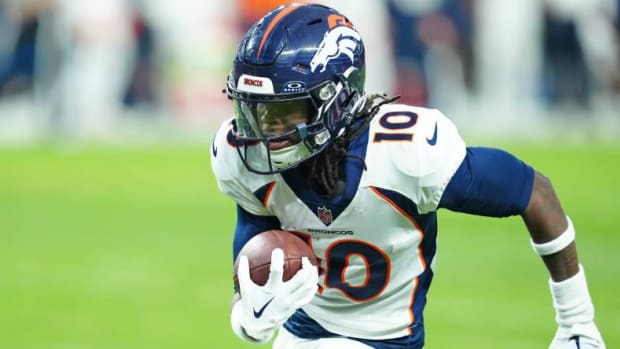Rookie Spotlight: Indianapolis Colts WR Michael Pittman Jr.
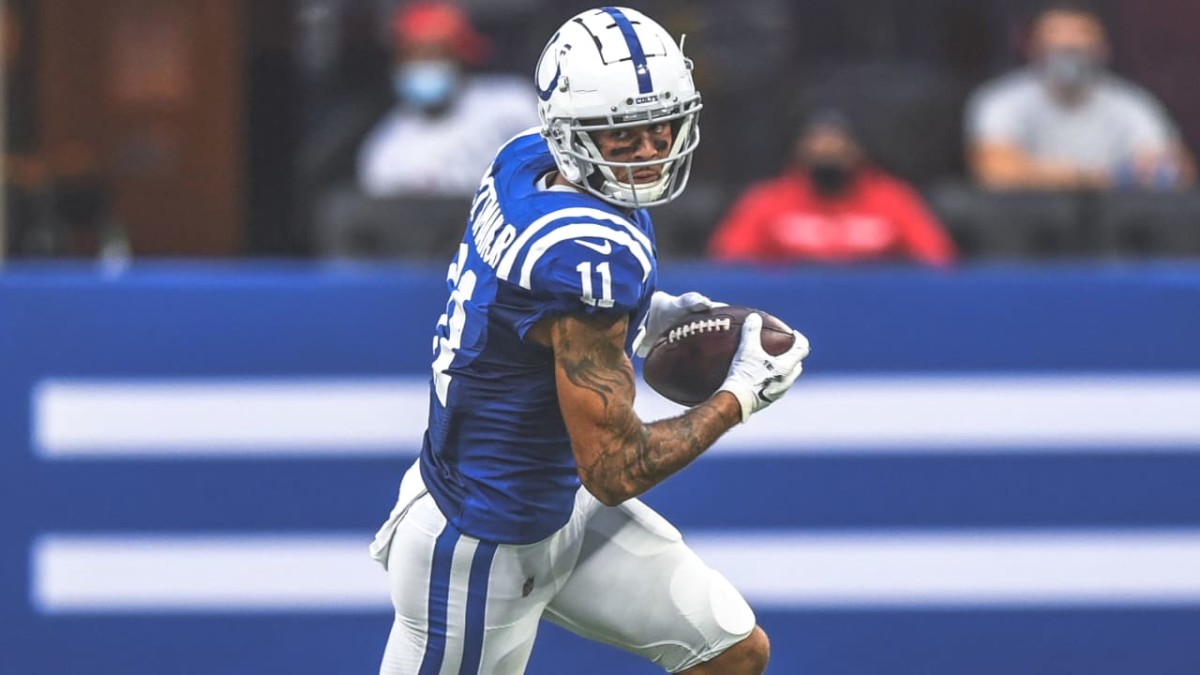
It was a daunting task to stand out amongst the 2020 NFL Draft wide receiver class. The immensely talented group was led by the trio of Jerry Jeudy (Alabama), Henry Ruggs III (Alabama) and CeeDee Lamb (Oklahoma). That said, there were various other notable names like Jalen Reagor (TCU), Justin Jefferson (LSU), Brandon Aiyuk (Arizona State) and Tee Higgins (Clemson). These possible early-round selections were just some of the numerous pass catchers with the talent to make an immediate impact in the NFL. As the 2019 college football season and the 2020 pre-draft season wore on, another player to also establish himself as a notable member of the potentially-historic receiver class, Michael Pittman Jr. of USC.
Once the 2020 NFL Draft had arrived, it was no surprise to see the duo from Alabama and the Oklahoma star be the first three receivers off the board. Ruggs III was picked No.12 overall by the Las Vegas Raiders, Jeudy was picked No.15 overall by the Denver Broncos and Lamb No.17 overall by the Dallas Cowboys. In such a talented position group, it was no surprise when three more receivers were selected in the first round. Reagor was taken with the No.21 selection by the Eagles, Jefferson was chosen with the No.22 by the Vikings and Aiyuk was picked by the 49ers at No.25. It did not take long into the draft’s second round for more pass-catching talent to be selected. The Cincinnati Bengals took Higgins with the first pick of the draft’s second day (No.33 overall). Then, the Indianapolis Colts chose Michael Pittman Jr. with the No.34 overall pick of the draft and the second overall selection on Day Two.
Despite lasting until the early second round, the former Trojans playmaker had an illustrious collegiate career. Pittman was a legitimate contributor for three of the four years he played at USC. His senior year, though, stood out as his breakout season. He was a near-unanimous All American Second Team selection in 2019. In the same year, he was a near-unanimous All-Pac 12 First Team selection and was named to the coaches’ All-Pac 12 Second Team as a special teams player. Pittman was also a finalist for the 2019 Biletnikoff Award, given annually to the nation’s top receiver.
On top of his performance on the field, the star receiver was recognized for his impact in the locker room and the University Park neighborhood. Pittman was given the 2019 Pop Warner College Football Award, signifying his impact on the field, in the classroom and in the community. Moreover, he was a finalist for both the 2019 Witten Award for college football’s man of the year and the 2019 Lombardi Award that recognizes a player’s performance, character, leadership and resilience. Additionally, he was given USC’s 2019 Community Service Award and Lifter’s Award.
Finally, the All-American was recognized within the USC football program for his stellar campaign. After being named team captain before the 2019 season, Pittman was recognized as USC’s 2019 MVP after the Trojans’ impressive year. During the pre-draft process, the decorated player was also invited to the 2020 Reese’s Senior Bowl, establishing him as one of the nation’s top seniors.
On top of his extensive list of accomplishments, the USC Trojan was a standout prospect whose size and athleticism were his first distinguishing traits. The senior measured in at 6-foot-4 and 223 pounds at the 2020 NFL Combine. He also boasted 32 1⁄2” arms, a high number for the position. For a player his size, Pittman could move. He ran the forty-yard dash in just 4.52 seconds, had a vertical jump of 36 1⁄2” and a horizontal jump of 10-1. His 6.96 three-cone drill and 4.14 twenty-yard shuttle, while around average in general, were notable for a player of his height and weight.
While big receivers often struggle to run routes, USC’s star pass-catcher was an outlier. Pittman had clean feet and was able to make fairly sharp cuts in his breaking routes. What’s more, he used head fakes, jab steps and body language up the route stem to force defensive backs into false steps or early hip turns. This was particularly effective because of the cautious defensive back play Pittman typically faced as a result of the threat he posed downfield. Moreover, the all-conference player fought hands throughout his routes to complement his movement skills.
A receiver’s ability to separate and win on a route is largely linked to their release on that snap. Pittman was able to combine his surprisingly quick feet with clean and accurate hands to keep defenders off of his chest at the line of scrimmage. By avoiding contact, the multi-talented senior created a smooth path to the top of the route stem.
On top of his impressive work prior to the catch point, the All-American was one of the most reliable receivers in the 2020 draft class. Pittman was a ‘hands-catcher’ with a wide catch radius. Moreover, he had impressive tracking skills and was always a threat to work back to the ball and bring it in during contested situations. Similarly, he used his length and strength well on fifty/fifty balls to overpower college defensive backs. Pittman’s body control both while high pointing and on the sideline made him a dangerous threat to secure any somewhat-accurate throw. He also used his size to shield the catch point from defenders. The Trojans’ 2019 MVP was more than just an above-average route runner, he was a physical receiver who knew how to use his size and could be relied upon to make most grabs within his catch radius.
After the catch, the talented senior was able to capitalize on his physical traits and serve as a viable threat with the ball in his hands. Indeed, USC’s All-Pac 12 receiver was a powerful ball carrier. He consistently exhibited impressive contact balance and leg drive which, consequently, enabled him to work through arm tackles. What’s more, his linear athleticism gave Pittman the ability to capitalize on any broken tackle.
A player with undeniable strength and size, the highly-decorated receiver was also a reliable run blocker. Pittman used his length and strength to engage and occupy defensive backs outside the hashes. He generally approached the contact point with proper technique, breaking down in space and initiating with his long arms. Clearly a physical athlete, Pittman was also not afraid of laying a big hit on defensive backs when the opportunities presented themselves.
Despite his various appealing traits, USC’s 2019 Biletnikoff Award finalist was not a perfect prospect. Perhaps the most substantial hindrance to his NFL future was his limited ability as a mover. Although he was an impressive athlete for his size, Pittman lacked high-level burst and lateral agility. Consequently, he often was forced to make contested catches after having failed to separate from defensive backs.
While his route running was notable for a player of his physical profile, the former USC Trojan required further development in that area of his game. This was specifically a result of the limited route tree Pittman was asked to run during his college career. Moreover, the talented receiver rounded off his breaking routes at times, thereby creating an easier coverage situation for defenders. Additionally, the all-conference receiver often won downfield on contested catches as a result of his size, strength and reliability; however, he found himself in these difficult situations because he struggled to separate on vertical patterns thanks to his limited linear burst. Similarly, Pittman’s refined hand usage in his releases did not completely overshadow his lack of experience beating press at the line of scrimmage.
With the ball in his hands, USC’s top receiver in 2019 was one-dimensional. Pittman lacked creativity and would, at times, run straight to contact. Although he was a strong college player, intentionally working towards tacklers as a ball-carrier is an inefficient plan. One reason for this tendency could have been Pittman’s lack of shiftiness. Indeed, the young receiver consistently struggled to make defenders miss and evade tackles in space. Most of his big plays after the catch came as a result of his lower body strength relative to college defensive backs.
These flaws were not particularly deleterious to the USC product’s outlook in the NFL. In fact, his playstyle largely mitigated or otherwise accounted for his weaknesses. As a result of his overwhelmingly positive traits, the highly-decorated athlete was taken at the top of the second round with the Colts’ first selection of the 2020 NFL Draft.
Since then, the former Trojan has had an up-and-down statistical year after a limited offseason thanks to COVID-19. Pittman ended his rookie season with 503 receiving yards and one touchdown. That total does not include a 90-yard performance in Indianapolis’s lone 2020 playoff game. Pittman’s volatile game-to-game numbers exemplify his inconsistent-but promising year. His season-high in yardage was 101 while his season-low was just six. That Week Three injury, compartment leg syndrome, forced Pittman to miss Weeks Four-through Seven, while recovering from surgery. All the same, there are various reasons for optimism regarding the former second-round selection’s future.
During his first NFL season, the rookie has shown he has the potential to succeed in the league. While his all-around athleticism is generally mitigated by more talented competition, Pittman’s play strength and long speed have shown up on tape. These physical traits have enabled him to stand out at times on the field.
When releasing against press coverage, Indianapolis’s first 2020 draft pick has already shown that he has the awareness and technical refinement to fight hands. In doing so, Pittman successfully keeps defenders from making contact with his frame. What’s more, he has the functional strength to legitimately put defensive backs off balance with his initial punch at the line of scrimmage. Moreover, his usage of his hands in his releases enables him to capitalize on poor press technique.
As a route runner, the former All-American separates thanks to his strength, hand usage and more-than-sufficient long speed. Pittman can work through physical defenders by swiping their hands away in the contact window. At the top of the route stem, he skillfully employs push-offs to gain a step on the defensive back. The second-round pick is also capable of making fairly sudden and sharp inside cuts to gain leverage against off coverage. That said, Pittman thrives on vertical routes. He uses subtle directional changes, head fakes and jab steps to manipulate cornerbacks and even deep safeties over the top. After making his break or working downfield, Pittman’s feel for leverage and long speed enable him to separate enough to make a play on the ball considering his wide catch radius and large frame.
While separating is a crucial aspect of wide receiver play at any level, it is matched or surpassed in importance by ball skills. The former All-Pac 12 player boasts consistent and reliable hands. Pittman looks the ball in and secures it while anticipating contact. Furthermore, he shields the ball at the catch point from defensive backs with his large frame. Pittman also tracks the ball well and adjusts to it at a high level. While he has not had many opportunities to compete in fifty/fifty situations due to unideal usage and questionable target distribution, the rookie has shown signs of carrying over his best trait from college by displaying a large catch radius and a physical mindset at the catch point.
Although the former Trojan was primarily a jump-ball receiver in college, his touches in the NFL have largely come on underneath routes, screens and end-arounds. This has allowed Pittman to show off his ability after the catch. Indeed, most of his big plays to this point have been made as a ball-carrier. The former second-round pick’s physicality in every other phase of his game carries over to his work with the ball in his hands. Pittman attacks the tackle point with a lowered shoulder and high leg drive to fall forward through contact. He also boasts sufficient balance and an active off-hand to force missed tackles. What’s more, the rookie follows his blocks effectively and with proper timing.
Above all else, the talented receiver has stood out as a blocker. Pittman has the length to initiate contact and latch onto defensive backs outside the hashes. Indianapolis was so confident in its young receiver’s blocking ability that coaches trusted him to line up as an H back. From that alignment, Pittman was tasked with engaging defensive ends and maintaining blocks briefly before releasing into his routes. The former Trojan’s physical mindset was also on clear display as a blocker, as he exhibited a high motor, sought out contact and regularly attempted big hits when the opportunity presented itself.
Although the Colts’ early-round pick exhibited various positive traits during his first NFL campaign, his rookie year was somewhat underwhelming relative to his talent and potential.
First and foremost, the Indianapolis coaching staff and quarterbacks did not use their rookie receiver in a way that would maximize his impact. Pittman’s best plays in college came on downfield routes, where he competed physically for the ball. Even though his size and strength translated well to the NFL, his rookie year saw him used primarily on underneath routes, breaking routes and schemed touches. When given the opportunity to work a vertical route tree, Pittman excelled and proved he was able to stack receivers and gain leverage downfield. Furthermore, his best work up the route stem to deceive defensive backs and force false steps that came on deep posts or go routes. All the same, Pittman was targeted downfield far less than he was open. In his future development, the fact that he succeeded on a number of his manufactured touches should not outweigh the potential he exhibited as a physical deep threat.
That is not to say that the rookie’s largest issues on film are out of his hands. Pittman’s signs of promise have been regularly accompanied by negative tendencies or traits. For example, the young receiver does not consistently employ his hands when releasing from the line of scrimmage. As a result, Pittman can be jammed by physical corners. This can throw off his route’s timing and spacing.
When running his underneath breaking routes, the Colts’ second-round selection has struggled to separate. This is largely due to concerning burst off the line and a tendency to round off his routes. The combined effect of these negative habits is that Pittman allows defensive backs the time to read and react to his movements. Similarly, the talented receiver does not convincingly sell his routes. In other words, he does not force defenders into mistakes with jab steps, head fakes and body language while working the route stem. Moreover, the rookie has not sufficiently exhibited the requisite fluidity to run curl routes or sharp breaking routes without losing speed through his cuts. While separating underneath has never been his greatest strength, his usage in Indianapolis has revealed concerning aspects of his play that Pittman must improve upon.
While a physical mindset as a blocker is an excellent trait, the former Senior Bowl standout can become reckless. Pittman sometimes attacks the point of engagement without breaking down or squaring up to his assignment. Should a defender dodge his block, the USC product whiffs and is largely unable to recover.
It is also worth noting that the early pick made rookie mistakes far too often in his first year. Pittman broke inside on multiple curl routes that, based on the quarterback’s ball placement, were meant to break outside. Moreover, the young receiver was flagged for a false start several times in his rookie campaign. Several more early jumps should have been penalties but ended up as non-calls. Finally, Pittman struggled in his biggest game of the year: the Wild Card matchup with Buffalo. In that game, the typically-sure-handed receiver dropped three passes - one would have been a touchdown. He also fumbled during the Colts’ last drive of the game while his team was down just three points. Luckily, the ball went out of bounds. Rookie mistakes are named as such for a reason. That said, Pittman will need to completely eradicate these issues from his game moving forward.
Despite these negative aspects of his play, it is crucial to remember that the second-round pick was operating under unique circumstances and should be afforded time to progress and develop. Pittman’s offseason was cut short by COVID-19 and his in-game experience was further limited by an injury and subsequent surgery. The former All-American’s usage in Indianapolis revealed various issues that must be addressed before he can become a game-in, game-out weapon in the NFL. Indeed, continuing to use him as he was employed in his rookie year would be a disservice to his skill-set and would limit his impact in the league. That said, Pittman has shown potential as a physical deep threat and has proven that his functional strength has carried over to the professional game. If afforded opportunities to play to his best traits, Michael Pittman Jr. may develop into a legitimate contributor in the NFL.
For a more in-depth read on his strengths and weaknesses in college, below you can read my 2020 NFL Draft scouting report on Michael Pittman Jr. based on his play at USC:
STRENGTHS
Not many players are as accomplished as this fourth-year senior. Pittman was named USC’s team captain and team MVP in 2019. He was also given the USC Lifter’s Award in his final year in Los Angeles. Moreover, Pittman was named a Biletnikoff Finalist in 2019 while simultaneously being picked almost unanimously as a First-Team All-Pac 12 receiver. He was also recognized by conference coaches as a Second-Team All-Pac 12 player on special teams in 2019. On top of this already-extensive list, Pittman was a near-unanimous Second-Team All American in 2019. The young receiver was also invited to the 2020 Senior Bowl, where he excelled with his size and route running.
The USC product’s impact was not limited to his work on the field. Pittman was also given USC's Community Service Award. Similarly, he won the 2019 Pop Warner College Football Award for a senior who has made an impact on the field, in the classroom and in the community. Pittman was further recognized nationally when he was named a finalist for the 2019 Witten Award, awarded to college football’s man of the year. The clearly-impressive young man was also named a semifinalist for the 2019 Lombardi Award, given to a player based on their performance, character, leadership and resilience.
On the field, the USC star is a big, long, physical receiver who is very athletic for his size. He backed up his apparent positive traits with a strong showing at the 2020 NFL Combine, both in terms of measurements and athletic testing. He recorded a 4.52-second 40-yard dash, a 36 1⁄2” vertical jump and a 10-1 broad jump. He also measured in at 6-foot-4 and 223 pounds with 32 1⁄2” arms.
Receivers of that size are not often recognized for their route running. That said, Pittman is fairly fluid and loose. He also flashes some clean and quick feet, considering his large frame. When breaking off underneath routes, the USC product is generally fluid and clean in his transitional movement. Pittman is also able to sell his routes to force defensive backs into mistakes. He uses jab steps, head fakes and subtle body language to manipulate defenders while working the route stem. The athletic receiver is also able to fight hands throughout his route to keep his frame clear of contact. What’s more, the senior sells his deep routes hard to make defenders flip their hips early before breaking off underneath. A talented deep threat, Pittman can capitalize on defensive backs’ overly-cautious play by making plays at the short to intermediate levels of the field. Furthermore, the All-American is a patient player who has a nice feel for zone coverage. At the top of his route stem just after his break, Pittman snaps his head around to look for the ball and make himself a target.
When releasing from the line of scrimmage, the Senior Bowl standout relies on his hands and power to beat press coverage. He accurately swipes defenders’ hands away from his frame which allows him to maintain the route’s timing.
Perhaps his best trait, the USC product is excellent at the catch point. Pittman has strong hands and boasts the length, power and frame to catch the ball through contact. He uses his large body to his advantage by shielding the ball from defenders at the catch point. What’s more, USC’s 2019 captain tracks the ball at a high level and high points it with ease. When necessary, he is fully capable of working back to an underthrown pass. A physical receiver who excels in 50-50 situations, Pittman can fight hands while the ball is in the air to win the positioning battle. He also has impressive body control on the sideline and in the air while adjusting to the ball. The Biletnikoff Finalist’s size and length also give him a large catch radius.
With the ball in his hands, USC’s star receiver is dangerous thanks to his physicality. When working as a ball-carrier, Pittman has solid contact balance and a willingness to take on contact. Moreover, the senior has the play strength to take on and run through arm tackles. Similarly, he churns his legs to pick up yards after contact. Although he is not a blazer, Pittman has sufficient long speed to complement his determination after the catch.
With his size and strength, USC’s All-Conference receiver and special teamer has the potential to be a high-level blocker. In fact, he is already very talented in that area. Pittman uses his length to his advantage, regularly initiating contact and keeping defenders in front of him as he breaks down. Further, he has an impressive anchor when taking on defensive backs outside the hashes. Clearly a physical player, Pittman has no issue laying a big hit if the opportunity presents itself.
WEAKNESSES
Although USC’s star receiver boasts solid long speed, he lacks high-level burst off the line of scrimmage. As a result, Pittman does not separate with speed; rather, he relies on his physicality and route running. Moreover, the young receiver lacks lateral agility and quickness.
The USC offense does not ask its receivers to run a complex set of routes. As a result, Pittman has little experience with a full route tree. That said, he has the potential to develop into a talented route runner relative to his size. At the moment, the All-American receiver can round his routes off at the top of his route stem. Additionally, he struggles to separate on go routes and is forced to win with his catch radius and strength at the catch point. It is also worth noting that Pittman does not have sufficient experience beating press to be relied upon early in that role. That is not to say he is incapable, he just has not faced much press coverage.
With the ball in his hands, the USC product lacked creativity. Pittman barely attempted to make defenders miss; instead, he relied on his size and strength to break tackles. The reason for this tendency may have been his trouble evading tacklers as a result of his limited lateral agility.
In an extremely deep wide receiver class, USC’s star pass-catcher distinguished himself as an early-round player. In his first year with the Indianapolis Colts, Pittman struggled in a role that did not properly suit his talents. All the same, he exhibited concerning traits that must be improved upon for him to find consistent success in the NFL. That said, the USC Community Service Award recipient showed promise when given the chance to work downfield as he did with the Trojans. Moving forward, the second-round pick’s development may depend on his usage and experience. This will be the rookie’s first full offseason with the Colts wherein he may prove himself as a physical deep threat. Given his size, athleticism and skill, Michael Pittman Jr. can become a dangerous weapon in the NFL.
Be sure to check back for next week’s Rookie Spotlight article for a deep dive into Philadelphia Eagles offensive lineman, Jack Driscoll.

